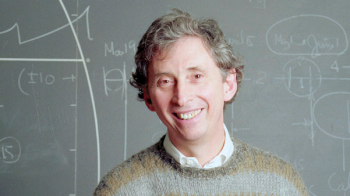LIGO: The Way the Universe Is, I Think, screened at CineGlobe, CERN, on 26–28 August, and directed by Hussain Currimbhoy, Carrie McCarthy and Mark Pedri

This short film focuses on mechanic turned physicist Rana Adhikari, who contributed to the 2016 discovery of gravitational waves with the Laser Interferometer Gravitational-wave Observatory (LIGO). A laid-back, confident character, Adhikari takes us through the basics of LIGO, while touching upon the future of the field and the public’s view on fundamental research, all while directors Currimbhoy, McCarthy and Pedri facilitate the conversation, which runs at just over 12 minutes.
Following high-school, Adhikari spent time as a car mechanic. Upon reading Einstein’s Medium of Relativity during Hurricane Erin, however, he decided that he wanted to “test the speed of light.” Now, he is a professor at Caltech and a member of the LIGO collaboration, and was awarded a 2019 New Horizons in Physics Prize for his role in the gravitational-wave discovery.
In the film, recorded in 2018, Adhikari explains how fundamental research can be something everyone can get behind, in a world where it is “easy to think we’re all doomed,” and describes the power that rests on collaborations to show the importance of coming together, expressing, “It is a statement of collective willpower.” Through varying shots of him at a blackboard, in and around his experiment, and documentary-style face-to-face discussions, the audience quickly gets to know a positive thinker for whom work is clearly a passion, not a job.
The directors trust Adhikari to take centre stage and explain the world of gravitational waves through accurate metaphors that seem freestyled, yet concise. A sharp cut to a shot of turtles seems unnatural at first, before transforming into an analogy of Adhikari himself – the turtles going underwater and popping their heads up into different streams representing Adhikari’s curiosity, and how he got into the field in the first place.
The film is littered with references to music, most notably with comparisons between guitar strings and the vibrations that LIGO physicists are searching for. After playing a short, smooth riff, Adhikari states his unusual way of analysing data. “It is easier to do maths later – sometimes it’s better to just feel it.” He then plays us the “sound” file of two black holes colliding; a short chirp that is repeated as punchy statements about the long history of gravitational waves are overlayed onto the film.
We should be exploring fundamentals driven by curiosity
Towards the end, the focus takes a shift towards the public’s view on fundamental research. “Lasers weren’t created to scan items in supermarkets,” states Adhikari. “We should be exploring fundamentals driven by curiosity.” The film closes on Adhikari discussing the future of LIGO, tapping a glass to cause a lengthy ring representing the search for longer-wavelength gravitational waves.
Through Adhikari’s story, LIGO: The way the universe Is, I think will inspire anyone who feels alienated or intimidated by fundamental research.







